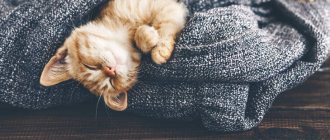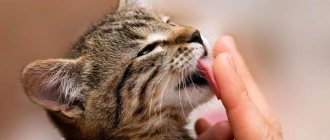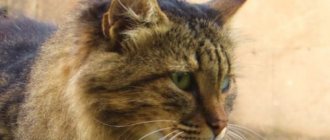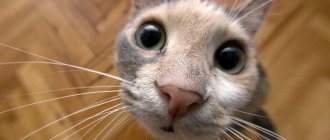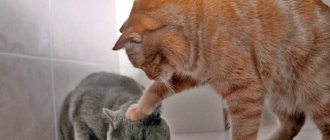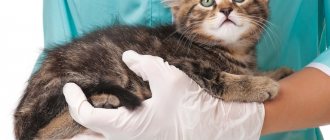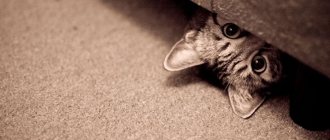My man!
If a cat “kneads” the knees, chest or other parts of its owner’s body with its paws, this, according to the “milk step” theory, indicates that the pet perceives the person as its mother. At least, this is what the authors of the publication “Kagouletheband” think. Cats calm down when they are in close proximity to their “native” creature, and therefore are perplexed if they are suddenly driven away.
The same can be said regarding the version concerning the glands on the paw pads. If you follow the logic of this theory, then cats trample on the body of their owner precisely in order to mark him. When a person has the appropriate scent marks, the cat will no longer be afraid of competition.
In addition to people, in almost every house or apartment there are also these people’s pets. Fish, parrots, hamsters, guinea pigs and decorative rabbits. But probably dogs and cats occupy the most honorable place. What kind of house is this without a cat? Why do we love them so much and they love us back?
Have you noticed the moments when your favorite animal jumps onto its knees, onto its back, whichever is more comfortable for it, and begins to shift from paw to paw, or “march” in one place. This action is reminiscent of a massage. This action begins slowly and carefully. Then the rhythm speeds up, the cat’s movements become sharp, and, as if by chance, the claws come into play. If you think of stomping a cat as a massage, then when you feel the claws, consider this moment the culmination of the “holiday”.
It is very difficult to answer the question: “Why does a cat trample you with its paws?”
Therapeutic effects on humans
According to professional breeders, pets are capable of healing. This theory is partly true. It has been scientifically proven that they can help a person.
Treatment with cats or feline therapy is a therapeutic technique that anyone can resort to if they are not allergic to wool. Cats are able to sense the owner’s mood; if treated gently, he will come to the rescue when you need to relieve tension.
In addition to the fact that cats help you feel better, their purring calms the human nervous system.
However, rumbling has another function - thickening the bones. Pets use it to heal fractures, since the frequency of sound vibrations from 20 to 50 Hz has a positive effect on bone tissue.
Doctors recommend communication with cats for people diagnosed with schizophrenia, cerebral palsy, and autism. Regular communication will help in socialization of children, becoming a good friend. The care shown by pets normalizes the human condition.
Reasons why cats knead blankets with their paws
For kittens, such paw movements are one of the very first. As soon as they are born and reach their mother's nipple to feed, they begin to knead their mother's belly with their front paws. Thus, the main reason why a cat gets under the covers is its memories of its own childhood.
These movements stimulate milk to be produced better and more actively, which is very important for newborn kittens. At the same time, when a cat grows up and is separated from its mother, its instincts do not disappear anywhere. When wondering why cats knead the blanket with their paws, you should understand that at this moment they are happy, feel comfortable and safe. This awakens childish behavior, your pet feels as if he is again near his mother and crushes her with his paws.
But there are other reasons why a cat tramples a blanket.
Back to the childhood
Often cats, settling down on some soft surface (pillow, rug, blanket), begin to move on this surface, alternately with both front paws. Sometimes animals can even extend their claws. They purr with pleasure, and sometimes it even seems that the pets fall into a kind of trance. According to scientists, this is how cats return to childhood, The Nest reports. The fact is that zoologists call the actions described above the “milk step.” Kittens use this “step” to stimulate the release of milk from the mother’s breast. This is why even adult cats sometimes smack their lips while stomping on the bed.
It is clear that the “milk step” evokes pleasant emotions in our pets, thanks to which they become so carried away by such actions that one might think that they are actually in some kind of trance. In reality, such monotonous, “childish” movements calm cats, just as babies immediately stop being nervous when they cling to their mother’s breast. It is noteworthy that some researchers believe that artificially fed cats never knead with their paws. However, most cat lovers disagree with this opinion.
Watch out for claws
Interestingly, cats love to knead mainly soft, pleasant fabrics, while some of them extend their claws, while others do not. If your furry has gotten into the habit of “rubbing” your knees, don’t rush to scold him. Firstly, the cat is completely relaxed, under the influence of endorphins and certainly does not expect rudeness from you. Secondly, by frightening an animal that has trusted you, you risk losing your close connection with it forever.
If your cat injures you with its claws during the milk step, gently press it to the surface. Eventually she will calm down and sit relaxed on your lap. Alternatively, knowing about your pet’s habits, you can lay a thick blanket or towel over yourself in advance.
Why cats trample us with their paws: Eight answers to one question
To the question: “Why do cats trample us with their paws?” no one can give a definite answer.
There are many versions, each of which has the right to life, but there is not a single scientifically based verdict.
However, owners of furry friends love their pets even without explaining their behavioral reactions.
However, many cat lovers want to know what motivates a cat to give a cat paw massage.
Representatives of the cat guild are often called sybarites - they really love comfortable conditions.
In the house, the cat chooses its own bed, settling in the most comfortable, clean and warm place.
A fluffy beauty curled up into a ball is the personification of bliss and comfort.
Some researchers explain the desire of cats to create comfortable conditions even in the wild for their habit of trampling a person, bed or toys with their paws.
It is believed that a wild cat, in its desire to make its sleeping place as comfortable as possible, tramples down leaves and branches so that it can sleep sweetly and comfortably.
Cats of all breeds love to trample their paws, from baby munchkins and graceful bengals to giant pets like ragdolls or caracals.
Domestic cats also sometimes like to make a nest for themselves and sleep in the grass
The milky step is a sign of love and trust in its owners
Many cat lovers, explaining why a cat tramples a blanket with its paws, adhere to the version that in this way the animals express their gratitude, trust and love for their owners.
This is how they show the highest degree of satisfaction.
The roots of this habit must be sought in the cat’s childhood, when small kittens nestle comfortably on the mother cat’s belly.
Having sucked on the nipple, they alternately move their paws to excite the receptors that are responsible for lactation.
The kittens are cozy, warm and nourished, they feel protected and happy, falling asleep to the affectionate song of their mother
In many cats, the childhood reflex is firmly established and, as they grow up, they happily trample people with their paws and purr.
This behavior has its own name - the “milk step”.
This is a special, trusting relationship between animals and their owners.
Important! This behavior of a cat manifests itself only in cases where the animal trusts its owner to the utmost. With strangers, felines most often behave reservedly and warily.
Cat owners should understand that even if sharp claws scratch the skin during this game, there is no point in scolding or punishing the animal.
The milk step is the highest manifestation of devotion to the owner and the opportunity to once again feel like a little kitten, protected from the vicissitudes of fate by the cat-mother.
How to react to a milk step
Most people enjoy displays of cat love.
Owners are happy to offer their pets tired shoulders or other parts of the body during the day - cat massage perfectly relieves fatigue, soothes, and brings peace.
But it also happens differently. Some people simply don’t like it when a cat scratches the skin with its claws, and this sometimes happens if the animal gets carried away.
In any case, you should not chase away or spank the cat - it can be very seriously offended.
The cat does not understand why she is being chased away. She just wanted to confess her love to her owner.
What to do if the milk step is unpleasant for a person or the claws are severely scratched?
A few simple tips will help you maintain a trusting relationship with your pet:
- First you need to go to the nearest veterinary clinic and trim the claws. For those who know how, you can do it yourself. In some cases, a scratching post, which you can buy or make yourself, helps to cope with sharp claws;
- Place your palm under the cat's paws below the cat's pads. The cat will continue its actions, but its claws will not touch the skin;
- distract the animal with a toy or “yummy”;
- place a blanket or pillow under the paws.
I trampled my friend with my paws and got a little tired
Interesting! If a cat and a dog live in a family, the cat can show its recognition and love towards its four-legged partner. At the same time, dogs often really enjoy cat massage.
Do all cats trample with their paws?
Not every cat tramples a blanket with its paws.
It is believed that this reflex is absent in animals that were bottle-fed.
The artificial baby did not lie under his mother’s side and did not massage her with his paws. Therefore, the reflex did not take hold.
Also, if a cat has one or two kittens and a lot of milk, her babies do not need to “fight for a place in the sun” and massage the mammary glands with their claws - they are always full and happy.
Such cubs most likely will not trample their owners with their paws.
How do animals who don’t give cat massages show their love and affection?
They love to rub against their owners' legs and purr.
Some people like to sit in their owner's arms or next to them.
A cat rubbing against its owner's legs is one of the highest manifestations of feline devotion and love.
Emotional factor
Cats, like all living things, can experience stress.
It happens that a pet begins to trample the sofa with such frenzy that one cannot suspect echoes of a carefree childhood in this action.
And all because the owners made a lot of noise, did not feed them on time, drove them out of their favorite place on the chair, took away their favorite toy, etc.
And the cat begins to furiously torment the sofa, thus throwing out its dissatisfaction.
After such a surge of emotions, the animal, as a rule, calms down and can even go to make peace with its owner.
Complete harmony between four-legged friend and owner
Milk step from the point of view of biologists
It turns out that cat paw pads are equipped with a large number of sweat glands and ducts that secrete a secretion with a specific odor.
Scientists believe that when a cat tramples a blanket with its paws, it is marking its territory.
Since cats are members of the cat family, which are predators, in nature they need a fairly large area to hunt.
Any animal invading this territory must understand that this place is occupied.
Scientists believe that trampling in different areas is like installing unique “beacons” indicating that there is already an owner in this territory.
This applies not only to rare wild breeds such as the Savannah or Serval, but also to all representatives of the cat family.
The cat steps softly and silently, not a single twig should crack under its paws. Hunting, in a word
There are also a huge number of receptors on the pads.
When a cat tramples its paws, be it its owner or any other intangible object, it seems to be studying the properties of this object.
In natural conditions, such behavior is very important for the animal.
Since cats are predators and love to hunt, they must be able to move silently so that not a single branch crunches under their paws.
And before making a lunge towards the victim, wild felines can stomp around in one place for a long time.
This is how they evaluate the condition of the surface under their paws in order to estimate the optimal speed and force of the throw.
What healers say
Many people know firsthand that cats have a healing effect on humans.
After an animal undergoes a cat massage session, many people note a significant reduction in pain.
At the same time, the four-legged healer, with an instinct known to him alone, identifies the sore spot and begins to stomp on exactly where the problem is.
Of course, this version can be considered quite controversial, but official science does not refute it.
As a result of exposure to the skin with paws and claws, local irritation occurs.
In this area, blood circulation increases and processes similar to those occurring during a professional massage occur.
Home massage therapist
What do milk steps and the happiness hormone have in common?
As scientists have found out, during the moments of trampling, a huge amount of endorphin is produced in the body of your pet.
This hormone is a protective agent against stress and promotes a peaceful, relaxed state.
When a cat purrs and moves its paws, it calms down and returns to normal.
It happens that the animal is almost asleep and at the same time continues to automatically move its paws.
Typically, cats of all breeds spend a lot of time grooming themselves.
Scottish Straight cats, jungle cats, and the beloved Siberian cat - all furry cats love to keep their fur coats clean.
When tidying up their fur, these amazing animals lick their paws especially carefully, thus stimulating the production of endorphins.
Cat owners note that after cleaning their paws, their four-legged pets sleep very sweetly.
Surprisingly, nature has endowed these small predators with its own mechanism for relieving stress and fatigue.
Clean paws are not only hygiene, but also a lot of pleasure
Interesting! There is an opinion that when a furry creature tramples its paws and purrs, a person calms down, his thoughts are streamlined, and his worldview is harmonized. Cats have become not only good friends for humans, but also, probably, the most powerful cure for stress.
Why does a cat trample a blanket with its paws? The question to which both scientists and lovers of these affectionate, intelligent predators are looking for an answer remains open. And while people are looking for an answer, pets purr with pleasure, trample their paws and give moments of pleasure to their owners.
- Igor Bazhyn
Should I be scolded for such behavior?
Understanding why cats knead the blanket with their paws, the owner should under no circumstances punish the pet for displaying natural instincts. You should be understanding of the complex and peculiar behavior of the cat. Negative emotions, irritating intonations, and being thrown off your knees during the “milk step” can lead to stress and the development of a negative psycho-emotional state. The animal will stop trusting the person and will withdraw from communication with him.
The owner may not like the fact that the cat crumples his body due to the fact that some individuals can release their claws and injure him. In this case, it is advisable to keep a thick towel or small blanket nearby to lay on your lap. This will protect the owner from injury if the cat releases its claws.
You can stop the unwanted action by lightly pressing the cat against a soft surface. She will settle down and calm down. Stroking and gentle intonations will calm the pet, and it will stop kneading the owner’s paws.
The unusual behavior of domestic cats in the form of trampling in one place has a variety of reasons. Most often, a kind of ritual is associated with the natural instincts and psycho-emotional state of the animal. An attentive and affectionate attitude towards the pet at this moment is the only thing required from a loving owner.
Host actions
Ardent cat lovers are sympathetic to the instincts of their pets. People who meet their mustachioed pet for the first time may be dissatisfied with the manifestation of her feelings. Cats crush their owners with their paws, not always controlling their claws.
This habit leaves unpleasant marks on a person’s delicate skin. The following recommendations will help prevent this:
- Sharp, rude pulling of the animal from the “crushing” ritual is not allowed. Whatever the reason for this habit, the cat thus shows tender feelings towards its person. If the owner cannot understand her (he will scream and swear), she will stop trusting him. The consequence may be ragged corners due to the stress of the animal.
- For such purposes, it is better to have a thick blanket on hand that can be placed on your lap. It will save the owner's skin from claws without compromising the pet's instinct.
- If there is nothing at hand, the cat must be carefully distracted by playing or moved to another place.
- You can lightly press your pet with your palm and stroke it. In the “lying down” position, it will not be convenient for her to move either her hind or front paws.
